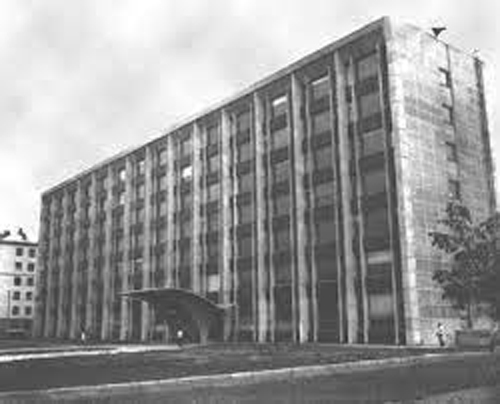Institute of Economics of the National Academy of Sciences of Ukraine
Institute of Economics of the National Academy of Sciences of Ukraine (Інститут економіки НАН України; Instytut ekonomiky NAN Ukrainy). A scientific research institute that existed from 1936 to 2005. It was founded in Kyiv in 1936 on the basis of the Agroeconomics Institute of the All-Ukrainian Association of Marxist-Leninist Scientific Research Institutes (VUAMLIN). In 1938 the Institute of Demography and Health Statistics of the Academy of Sciences of the Ukrainian SSR was incorporated into it. During Soviet times, the institute conducted and published research in political economy, planning and economic management, Ukrainian SSR’s economic growth and development, industrial economics, statistics and demography, Ukraine’s economic history, and economic thought in Ukraine. Its declared goal was a ‘scholarly generalization of achievements of socialist development,’ which in practice often meant the propaganda of economic policies and plans inherent in each five-year plan. During the period of Nikita Khrushchev’s ‘thaw’ (1953–1964) the institute began to focus on a number of practical economic issues; its branch in Kharkiv was opened (1957); and its main periodical Ekonomika Radians'koï Ukraïny was founded (1958). The 1960s saw an attempt at implementing an economic reform in the USSR attributed to Aleksei Kosygin, head of the USSR’s Council of Ministers. As a consequence, the institute grew substantially (its staff nearly tripled). With its branches in Lviv, Donetsk, and Odesa (established in 1964, 1965, and 1970 respectively), in 1980 it consisted of 30 departments with a staff of 1,080 (287 scholars). The institute operated three computer centers and trained graduate economists. It published monographs and collections, two interagency serials— Istoriia narodnoho hospodarstva ta ekonomichnoï dumky Ukraïns'koi RSR (from 1965) and Demohrafichni doslidzhennia (from 1969)—and the journal Ekonomika Radians'koï Ukraïny (1958–1991, thereafter Ekonomika Ukraїny).
In the 1990s, in connection with the dramatic changes in economy and society of independent Ukraine, the institute experienced reorganization. A separate scientific research institute—the Institute of Economic Forecasting (today the Institute for Economics and Forecasting of the National Academy of Sciences of Ukraine)—was created on the basis of the institute’s several departments in 1997. Its regional branches became separate scientific research institutes. In 2004 the institute was reorganized as the United Institute of Economics of the National Academy of Sciences of Ukraine, but it was liquidated next year due to a further reorganization of the economic research within the National Academy of Sciences of Ukraine. Today, economics is the main research focus of a number of separate scientific research institutes, including those that emerged on the basis of the Institute of Economics: the Institute for Economics and Forecasting of the National Academy of Sciences of Ukraine (Kyiv), the Institute of Regional Research of the National Academy of Sciences of Ukraine (Lviv), the Institute of Industrial Economics of the National Academy of Sciences of Ukraine (Donetsk, relocated to Kyiv), the Institute of Market Problems and Economic-Ecological Research (Odesa), and the Institute for Demography and Social Studies of the National Academy of Sciences of Ukraine (Kyiv). A number of prominent economic scholars worked at the institute, including Mykhailo Ptukha, Kostiantyn Vobly, Petro Liashchenko, Leonid Yasnopolsky, and Stefan Yampolsky. The institute was directed by Aleksandr Asatkin (1936–7), Vasyl Teplytsky (1937–8), Vasyl Rudnytsky (1939–41), Kostiantyn Vobly (1942–7), Yakiv Feigin (1947–8), Pavlo Pershyn (1948–50), Aleksei Rumiantsev (1950–2), Leonid Yasnopolsky (1952–3), Oleksii Nesterenko (1953–65), Stefan Yampolsky (1965–70), Petro Bahrii (1971–6), Ivan Lukinov (1976–2003), and Serhii Pyrozhkov (2003–5). (See also Economic geography, Economic press, and Economic studies.)
Serhiy Bilenky
[This article was updated in 2022.]
